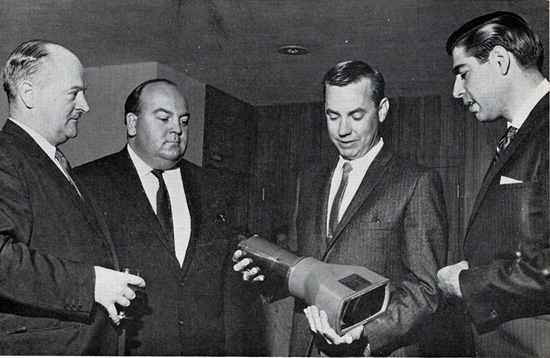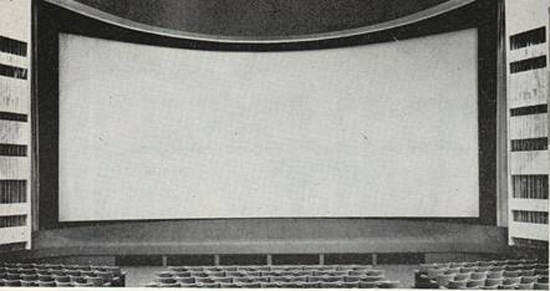D-150 developing single film 3-D without filters |
Read more at in70mm.com The 70mm Newsletter |
| Written by: Kinematograph Weekly, UK, around 1967. Prepared from vintage papers by Anders M Olsson, Sweden | Date: 01.01.2019 |
 Jock
Macgregor (Motion Picture Exhibitor), T.E. Chilton (assistant managing
director, Rank Audio Visual), Dr. Richard Vetter (vice-president, D-150 of
America) and Lawrence Hatch (a senior executive of D-150) discuss points of
the specially designed D-150 lens. Jock
Macgregor (Motion Picture Exhibitor), T.E. Chilton (assistant managing
director, Rank Audio Visual), Dr. Richard Vetter (vice-president, D-150 of
America) and Lawrence Hatch (a senior executive of D-150) discuss points of
the specially designed D-150 lens.A SINGLE-FILM system of 3-D presentation, which does not require two images (for left and right eyes) or polarising filters, is being processed by Dimension-150 Inc. This was disclosed by Dr. Richard Vetter, executive vice-president, at the demonstration of the D-150 deeply curved, widescreen projection system arranged by Rank Audio Visual at the Odeon, Marble Arch, on Thursday last week. Dr. Vetter stated that the 3-D concept had been satisfactorily demonstrated, but now requires refinement for large screen cinema presentation. Details were secret, he said, declining to answer questions. He also said D-150 had developed, in association with Ampex, an eight-channel sound system. This includes the usual five channels for behind-the-screen speakers, two channels for speakers on the left and right sides of the auditorium and one for rear auditorium overhead speakers. Existing 6-channel systems can be converted easily, said Vetter. But the 8-channel prints can be used with a 6-channel installation. Introduced by Edmond Chilton of Rank Audio Visual, Vetter explained the significance of the title Dimension-150. "The term refers to the maximum dimensional field of view, or scope, seen by the lens of the Dimension-150 camera. Our camera, equipped with its widest lens, captures a field of vision 150 degrees wide — which very nearly duplicates the human binocular field of vision. Most of you will recall that the combined three lenses of the original Cinerama system encompassed a mosaic field of 146 degrees which, in its time, was quite remarkable," he said. Two systems The Dimension-150 process embodies two systems: a photographic system and a projection system, he continued. In filming, D-150 provides the producer with all the necessary cameras, lenses and associated accessories. The 70mm cameras are modern, versatile Mitchell-built mechanisms. There is also a new hand-held camera weighing slightly more than 20 pounds, including film. It is designed as an all—purpose camera for use on the sound stage, in the air, on land and under water. In addition there is a wide range of lenses "of unprecedented quality, which our competitors have not succeeded in duplicating," claimed Vetter. These range from telephoto to extreme wide-angle, including 100 degree, 120 degree, and 150 degree lenses. New, distortion-free zoom lenses are also part of the camera package. The D-150 was designed to reproduce scenes, with multi-track stereophonic sound, on a wall-to-wall, floor-to-ceiling screen of 120 degrees curvature without washout of colour and contrast, without distortion, and with extraordinary definition — no simple task. It is capable of presenting all picture format with the facility for changing rapidly from one to another. "This most modern cinema in which we are meeting today has that flexibility," said Vetter. Slides illustrated the Cinema 150, near San Francisco, which has an 85 ft by 35 ft screen, said Vetter. "Illuminating this vast screen, is not in the least a problem. It is manufactured to our specifications by Andrew Smith Harkness, with a gain factor of 1.8 or greater and its unique surface prevents washout of colour and contrast. The screen is indeed a remarkable achievement," he added. The 35mm lenses are carefully matched to projection distance and screen size and curvature. The 70mm lenses are especially designed to curve the field of the image to coincide with the screen curvature. The Dimension-150 Super Curvulon projection lens, designed to D-150 specifications, eliminates distortion which would otherwise result on the vast 120 degree screen, in addition to matching the curvature of focus to the curvature of the screen." Reporting on D-150 film production and cinema installation progress Lawrence Hatch, director of marketing, said 20th Century Fox's "The Bible..." was the first production to be made on the D-150 process. Fox had now signed a contract for the production of the roadshow presentation, "Tora, Tora, Tora..." in D-150. Negotiations were being concluded for another major picture to be photographed and exhibited in D-150, and additional contracts are being drawn up for other productions. "The exhibitor equipped with D-150 is assured of continuity of roadshow product," he said. "There are D-150 installations in 18 major market areas. The next will be in Bogota, Columbia, scheduled for completion this month. We have concluded an agreement for at least four cinemas in Mexico. Before the end of the year, more than a dozen additional cinemas will be equipped with the D-150 system in other important cities throughout the world." For projection the following equipment, in addition to 70/35mm dual purpose projectors is required: D-150 screen; automatic masking for all picture formats, including Dimension 150; screen frame; tracks and automatic motors for the masking and main title curtain; all purpose control panels for the operation of all theatre equipment, including lights; lenses for all picture formats including special D-150 lenses designed for 70mm deep curve. For all installations, new cinemas and conversions, blueprints of the cinema are analysed and detailed drawings are prepared specifying all aspects of the physical installation. |
More in 70mm reading: Motion pictures photographed in Dimension 150 Come Back D-150 ....All Is Forgiven Internet link: |
 The
D-150 deeply-curved all purpose screen, 75ft wide with a 120 degree radius,
at the Odeon, Marble Arch. It was supplied by Andrew Smith Harkness, a
marketing unit of Rank Audio Visual. The
D-150 deeply-curved all purpose screen, 75ft wide with a 120 degree radius,
at the Odeon, Marble Arch. It was supplied by Andrew Smith Harkness, a
marketing unit of Rank Audio Visual.No conversion Said hatch, "Every D-150 all-purpose installation is custom designed and engineered. D-150 costs little more than a conventional dual 35mm/70mm installation. Of utmost importance is the capability of exhibiting ANY and ALL product at any time without costly conversions." Outlining the policy governing the exhibition of the films in D-150 Hatch said: "Once the installation is completed and paid for, the exhibitor is free to present films in 35mm wide-screen, CinemaScope, and 70mm without incurring any costs above and beyond the normal film rental terms customarily agreed to between the exhibitor and the distributor." "NO FEE OF ANY KIND IS IMPOSED UPON THE EXHIBITOR BY EITHER THE DISTRIBUTOR OR D-150. "Please allow me to repeat this most important point: the revolutionary D-150 Super Curvulon lenses and full, deeply curved D-150 screen are made available to the cinema for presentation of Dimension 150 pictures AT NO ADDITIONAL COST TO THE CINEMA. "D-150's revenue is derived from an agreement with the producer-distributor and does not include the exhibitor." It was stated later, however, that D-150 requires payment of a royalty of 5 US cents per admission (approximately 3½ per cent of box-office receipts) if a non-D-150 production is exhibited by the D-150 system. The demonstration showed the contrast in sizes of the screened images on the giant curvilinear screen with the showing of an extract from a "Look at Life" in standard format; an excerpt from Columbia's "The Professionals," which was shot in Panavision, and shown in wide-screen ratio; the Flood and Babylon sequences from "The Bible...", screened in D-150 dimensions, and finally part of the "Fortress of Peace," a fine documentary of Swiss army and air force defence exercises, an exacting test piece for D-150. It was an impressive exposition of the visually all-embracing scope of the D-150 shooting and reproduction systems and the efficacy of the optics. There was a notable absence of bent horizontals and converging perpendiculars. Definition across the screen was excellent; illumination even with insignificant fall-off at the edges; and no noticeable degradation of colour. Tom Harkness questioned the claim that the D-150 screen had a gain factor of 2, as stated in the brochure. It can vary, he said, between 1 and 1.2. Vetter claimed that in some cases it had been shown to be as high as 1.8, possibly higher. The maximum screen brightness achieved at the San Francisco installation with Ashcraft Super-Core-Lite arcs was 14-15 ft.-Lamberts in the centre and 10-11 ft.-Lamberts at the sides. Questioned about the use of Xenon lamps for D-150, Vetter said these were, at present, quite inadequate for screen widths up to 45 ft. Asked about the maximum permissible projection rake for D-150 Vetter replied that preferably this should not exceed 6 degrees, plus or minus. Asked why D-150 used a screen with a continuous surface, rather than a Cinerama-type louvred screen, Vetter said the latter was not desirable because the louvres were visible, especially from the front seats. Asked about the minimum distance of seats from the screen, Vetter said that the front row should be no nearer than one-fifth of the chord of the screen, measured from the chord. Replying to a question about the life of the screen, Tom Harkness said this was largely dependent upon the extraction of cigarette smoke away from the screen. A member of the audience said he found the reflection of light from the screen by the light decor of the side walls a distraction; there was enough reflected light to read a newspaper, he asserted. This was a matter for the cinema owner, replied Vetter. The really important thing was to get the light on the screen back to the audience. The Harkness D-150 screen at the Odeon is 75 ft wide and has a curvature of 120 degrees. Three Cinemeccanica Victoria 8 70/35mm projectors with automated lens turrets and Ashcraft Super-Core-Lite arcs, are installed in conjunction with Cinemeccanica C.65 transistorised sound system and the Cinemation automatic control system. The D-150 lenses, manufactured by Kollmorgen Corporation of America, weigh 16½ lbs each and incorporate 5½ inch f/1.9 lenses, and adjustable front components for varying the picture size by about 6 ft. |
|
|
ALL-PURPOSE FILM PRESENTATION SYSTEM AN all-purpose system of film presentation that accommodates all screen ratios without major changes in theatre equipment, was demonstrated by Rank Audio Visual on Thursday, July 6, at the Odeon, Marble Arch. The system, known as Dimension 150 (D-150), allows all aspect ratios, on both 35mm and 70mm film, to be presented with enhanced depth and clarity, and without distortion, on a 70ft curved D-150 screen. Dr. Richard Vetter, co-developer of the D-150 process, formerly connected with the audio visual department of the University of California at Los Angeles, and Lawrence Hatch, introduced the demonstration at which a series of specially prepared films was shown. The demonstration was attended by more than three hundred members of the industry, both from the United Kingdom and overseas. |
|
| Go: back - top - back issues - news index Updated 22-01-25 |
